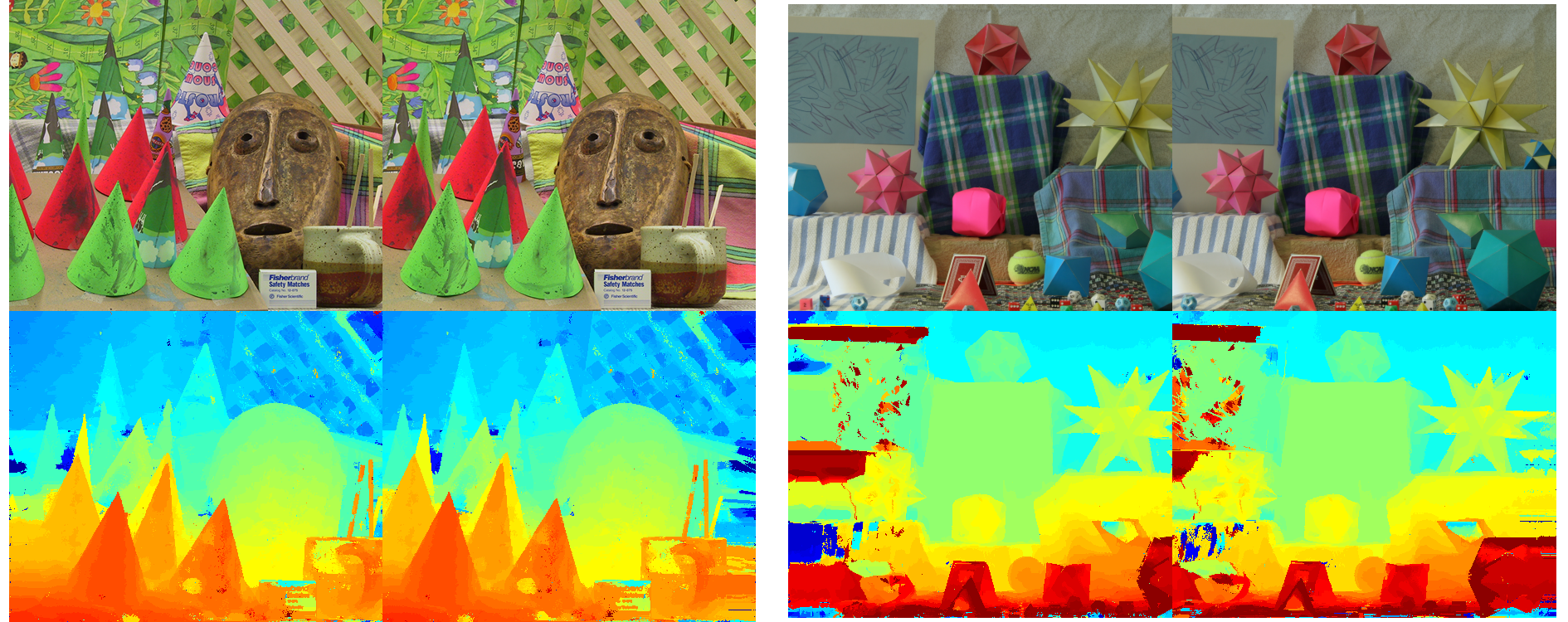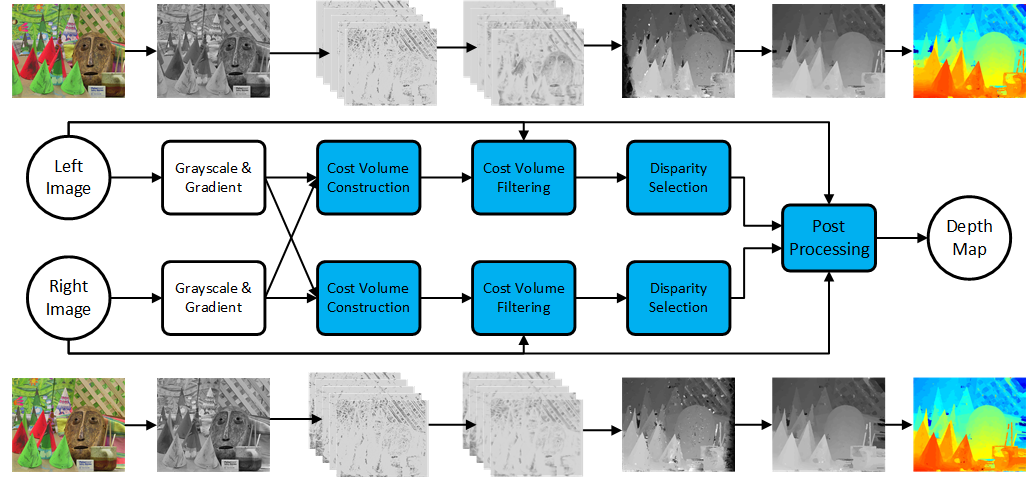PRiME-project / Primestereomatch
Programming Languages
Projects that are alternatives of or similar to Primestereomatch
PRiMEStereoMatch
Please use these citations in your publication if you use this work: (bibtex here)
Charles Leech, Charan Kumar, Amit Acharyya, Sheng Yang, Geoff V. Merrett, and Bashir M. Al-Hashimi. 2017. Runtime Performance and Power Optimization of Parallel Disparity Estimation on Many-Core Platforms. ACM Transactions on Embedded Computing Systems (TECS) Volume 17 Issue 2, Article 41 (November 2017), 19 pages. DOI: https://doi.org/10.1145/3133560
Leech, Charles (2018) Runtime energy management of multi-core processors. University of Southampton, Doctoral Thesis, 293pp.
Theoretical Background
A heterogeneous and fully parallel stereo matching algorithm for depth estimation. Stereo Matching is based on the disparity estimation algorithm, an algorithm designed to calculate 3D depth information about a scene from a pair of 2D images captured by a stereoscopic camera. The algorithm contains the following stages:
- Cost Volume Construction - weighted absolute difference of colours and gradients function.
- Cost Volume Filtering - Adaptive Support Weight (ADSW) Guided Image Filter (GIF) function.
- Disparity Selection - Winner-Takes-All (WTA) minimum cost selection.
- Post Processing - left-right occlusion check, invalid pixel replacement and weight-median filtering.
Implementation Details
- All stages of the algorithm have been developed in both C++ and OpenCL.
- C++ parallelism is introduced via the POSIX threads (pthreads) library. Disparity level parallelism is supported, enabling up to 64 concurrent threads.
- OpenCL parallelism is inherent through the concurrent execution of kernels on an OpenCL-compatible device. The optimum level of parallelism will be bounded by the platform & devices.
- Support for live video disparity estimation using the OpenCV VideoCapture interface as well as static image computation.
- Additional integration of the OpenCV Semi-Global Block Matching (SGBM) algorithm.
Installation
Prerequisites
- Hardware:
- Development Platform - preferably including devices supporting OpenCL
- Stereo Camera - to use the algorithm in video mode - the ZED Stereo Camera is used in our experimentation.
- Software Libraries:
- OpenCV 3.0 or later - Installation in Linux instructions
- pthread library for non-OpenCL execution on the CPU
- OpenCL Library for execution on the GPU
- cmake v3.2, git
Compilation
- Clone repo to the platform:
git clone https://github.com/PRiME-project/PRiMEStereoMatch.git - Enter the base directory:
cd PRiMEStereoMatch/. - Create a build directory:
mkdir build - Enter the build directory:
cd build - Invoke cmake to build the compilation files:
cmake ..(Two dots are required in order to reference the base directory) - Compile the project with the generated makefile:
make -jN.- Set N to the number of simultaneous threads supported on your compilation platform, e.g.
make -j8.
- Set N to the number of simultaneous threads supported on your compilation platform, e.g.
Deployment
-
Run the application from the build dir:
./PRiMEStereoMatch <program arguments> -
The program mode is selected with git-style commands. Valid commands include:
- video
- [optional] When specifying the video mode, the following arguments can be included:
- --recal - recalculate the intrinsic and extrinsic parameters of the stereo camera. Previously captured chessboard images must be supplied if the RECAPTURE flag is not also set.
- --recap - record chessboard image pairs in preparation for calibration. A chessboard image must be presented in front of the stereo camera and in full view of both cameras. Press the R key to capture a frame. The last frame captured is shown beneath the video stream.
- [optional] When specifying the video mode, the following arguments can be included:
- image
- [optional] When specifying the image mode, the following arguments can be included:
- -l [i]left image filename> -r right image filename
- -gt ground truth filename
- [optional] When specifying the image mode, the following arguments can be included:
- video
-
A set of global options also exist, which must be specified for all modes:
- -a (--alg=) - Set the default matching algorithm to run. It has options {STEREO_GIF, STEREO_SGBM}. This can also be toggled during executions.
-
For example, to run using a stereo camera, specify:
./PRiMEStereoMatch video
-
To run with calibration and capture beforehand, specify:
./PRiMEStereoMatch video --recal --recap
-
Image disparity estimation is achieved using:
./PRiMEStereoMatch image -l left_img.png -r right_img.png
-
The first time the application is deployed using a stereo camera, the --recal and --recap flags must be set in order to capture chessboard image to calculate the intrinsic and extrinsic parameters.
-
This process only needs to be repeated if the relative orientations of the left and right cameras are changed or a different resolution is specified.
-
Once the intrinsic and extrinsic parameters have been calucalted and saved to .yml files, the application can be re-run with the same camera without needing to recalibrate as the parameters will be loaded from these files. The files can be found in the data directory.
Interactivity
- Press h to display a help menu on the command line. This shows input and control options for the program which change the way the algorithm behaves for the next frame.
- Control Options:
- Matching Algorithm (a): STEREO_GIF or STEREO_SGBM
- STEREO_GIF:
- Numbers 1 - 8: (CPU only) change the number of simultaneous pthreads created
- m: switch the computational mode between OpenCL (GPU) and pthreads (CPU)
- t: switch the data type use for processing between 32-bit float and 8-bit char
- STEREO_SGBM:
- m: switch the computational mode between MODE_SGBM, MODE_HH and MODE_SGDM_3WAY
Directory Structure
folders:
assets - OpenCL kernel files
data - program data including input images, stereo camera parameters, calibration images
docs - images for the readme & wiki
include - Project header files (h/hpp)
src - Project source files (c/cpp)
files:
CMakeLists.txt - cmake project compilation file
LICENCE.txt - license file
README.md - this readme file
References
Code
Some components of the application are based on source code from the following locations:
rookiepig/CrossScaleStereo - The basis for some C++ functions (GNU Public License)
atilimcetin/guided-filter - CPU-based GIF implementation using the Fast Guided Filter (MIT License)
Literature
The algorithm in this work is based in parts on those presented in the following publications:
[Hosni2011CVPR]: C. Rhemann, A. Hosni, M. Bleyer, C. Rother, and M. Gelautz. Fast cost-volume filtering for visual correspondence and beyond. In CVPR, 2011
[Hosni2011ICME]: A. Hosni, M. Bleyer, C. Rhemann, M. Gelautz and C. Rother, Real-time local stereo matching using guided image filtering, in Multimedia and Expo (ICME), 2011 IEEE International Conference on, Barcelona, 2011.
[Ttofis2014]: C. Ttofis and T. Theocharides, High-quality real-time hardware stereo matching based on guided image filtering, in Design, Automation and Test in Europe Conference and Exhibition (DATE), Dresden, 2014.
[He2012]: K. He, J. Sun and X. Tang, Guided Image Filtering, Pattern Analysis and Machine Intelligence, IEEE Transactions on, pp. 1397-1409, 02 October 2012.
License
This software is released under the BSD 3 Clause License. See LICENSE.txt for details.
To cite this code in your work, please also include the following reference:
Charles Leech, Charan Kumar, Amit Acharyya, Sheng Yang, Geoff V. Merrett, and Bashir M. Al-Hashimi. 2017. Runtime Performance and Power Optimization of Parallel Disparity Estimation on Many-Core Platforms. ACM Transactions on Embedded Computing Systems (TECS) Volume 17 Issue 2, Article 41 (November 2017), 19 pages. DOI: https://doi.org/10.1145/3133560
Bibtex:
@article{Leech:2017:RPP:3160927.3133560,
author = {Leech, Charles and Kumar, Charan and Acharyya, Amit and Yang, Sheng and Merrett, Geoff V. and Al-Hashimi, Bashir M.},
title = {Runtime Performance and Power Optimization of Parallel Disparity Estimation on Many-Core Platforms},
journal = {ACM Transactions on Embedded Computing Systems (TECS)},
issue_date = {January 2018},
volume = {17},
number = {2},
month = nov,
year = {2017},
issn = {1539-9087},
pages = {41:1--41:19},
articleno = {41},
numpages = {19},
url = {http://doi.acm.org/10.1145/3133560},
doi = {10.1145/3133560},
acmid = {3133560},
publisher = {ACM},
address = {New York, NY, USA},
keywords = {Runtime management, computer vision, many-core platforms, power optimization},
}


